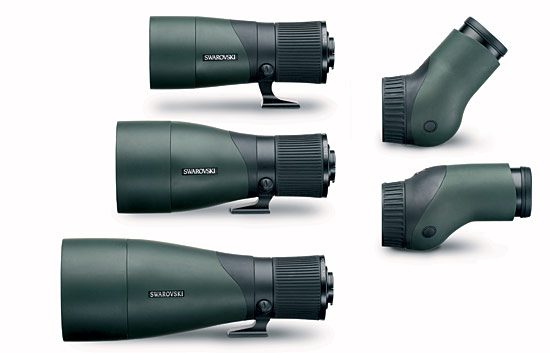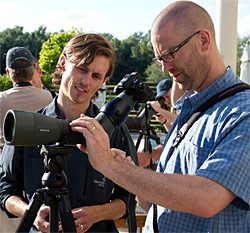For 2012, Swarovski Creates Spotting Scopes for Birders and Digiscopers
By Gustave Axelson July 20, 2012
On a recent trip to Hungary, science editor Gus Axelson got a chance to test out a new line of Swarovski Optik ATX spotting scopes, which were officially announced today. Although Gus was pretty new to digiscoping, he found this scope’s innovative design to be incredibly easy and intuitive for bird viewing, and for hassle-free digiscoping. Here’s his review:
The new ATX/STX line of scopes introduce some brand-new ideas to standard spotting-scope design. They feature modular components that can combine to give you a compact 65-mm, 25–60x scope; an 85-mm scope of the same power for an even brighter image; or a long-distance, very bright 95 mm, 30–70x scope. The design also features side-by-side focus and zoom rings for easy, fast bird viewing and a screw-on camera adapter that turns the scope itself into a mega-zoom lens.
Perhaps the most innovative feature of the new scopes is their mix-and-match modularity. Birders can choose between two eyepieces, angled (ATX) or straight (STX), and combine those with three different objectives (the big end of the scope, available in 65 mm, 85 mm, and 95 mm). So you can purchase one eyepiece and two objectives, say an ATX plus a 65-mm, 25–60x objective and a 90 mm, 30–70x, and you’ll have two different power scopes in the same set. The scopes twist apart and snap together in the middle, so swapping out the objectives is easy and quick—a lot like affixing different lenses to a camera.
Whereas conventional scopes build the zoom into the eyepiece, these new scopes include it on the objective lens, which is what allows you to change both the scope’s power and brightness by swapping objectives. It also makes possible another innovation: side-by-side placement of the zoom and focus rings. Having both controls under the fingers of one hand made the scope incredibly easy to use for this novice (and it should be an easy adaptation for experienced scopers). I was able to quickly get on a bird and get it into crisp view with just one hand, which meant my left hand was free to guide the scope. Getting close to birds in flight and following their flightpath was a breeze.
The modularity makes for flexibility in different birding situations. Say you’re packing to travel by airplane for a birding trip, or you’ll be hiking in the backcountry. Then you’d appreciate the lighter weight and compact size of the ATX 65-mm package (by snapping it in half, it easily fits inside a small backpack). But later on, you’ll be staying close to home to do some long-distance birding at the ocean shore or on a prairie. You can just twist off the 65-mm objective and go with the 95-mm package.
In addition to all these new features, the ATX scopes offered high resolution, stark contrast, and rich colors. On the Hortobagy grasslands, I watched a perching Red-footed Falcon and it seemed like I was watching a nature show in HD TV, even though I was well over a football field away.

Secure digiscoping and no vignetting
For digiscopers, the ATX package also offers a third attraction—camera adapters (sold separately), one for digital SLR cameras and another for point-and-shoot cameras. I used the former on my Panasonic GH-2. To attach it, I removed the lens on my camera body and affixed the adapter, which connects like a camera lens and then screws tightly to the scope’s eyepiece. The whole unit functions like a super-telephoto lens—with no worries about the holding the camera steady against the scope. I even carried the ATX scope with the camera on it, with no worries about it falling off. This set-up made it really easy to quickly move from spot to spot when trying to get a clear view and photos of birds flitting about in forest cover.
Connecting the camera this way totally eliminated vignetting—normally the bane of digiscopers—because the scope itself was functioning as the camera lens. It was also ideal for eliminating hand-shake blurriness, since I could set the timer on my camera and step away to let it shoot. I could even shoot video while watching through my camera’s LCD monitor, running continuously while I scanned, zoomed, and focused. (For an idea of the ease of use and lack of vignetting, see the two short video clips at the end of the post.)
A separate adapter works for point-and-shoot cameras, attaching them securely to the scope unit, with the added benefit of being able to swing the camera up out of the way to view through the scope directly.
Availability and Pricing
The ATX/STX scope packages will be on display at the British Birdfair in August. They’ll be available on the U.S. market around mid-September. Stateside birders can get sneak previews at a number of upcoming bird festivals—the Tucson Birding Festival in Arizona, Aug. 15–19; the Cape May Hawk Watch in New Jersey on Sept. 1; and at the Wine Country Optics Fair in Sonoma, California, on Sept. 9.
And pricing? Not surprisingly these are the Cadillacs of spotting scopes in a brand already at the top end of the market. The innovation and image quality does merit the price, but the package I mentioned above—an ATX or STX eyepiece ($2,421) plus a 65 mm objective ($976) and a 95 mm objective ($2,110)—would run you north of $5,000. The 85 mm objective, which offers the same zoom specs as the 65 mm but gathers more light (a crucial benefit for digiscoping), is $1,721 (total $4,142 with eyepiece).
Sample video clips
I found the secure camera attachment made taking video through the ATX 85-mm scope remarkably easy, even though I’d never attempted this before. In this clip, a Hawfinch preens on a treetop at dawn. The image is crisp enough that you can see the twig shake as the bird moves—and there’s no vignetting at the sides of the image.
I was even able to pan around while watching through my camera’s viewfinder, keeping the video running—something it would be quite hard to do with another scope. In this brief clip, I follow a Great Spotted Woodpecker as it works up a branch.
If you’re interested, read more at the official Swarovski Optik ATX/STX page, and check out reviews by other birders who tried out the scopes during the Hungary tour: 10,000 Birds, ABA Blog, Bird Watching magazine, Birding Frontiers.
(Full disclosure: Swarovski Optik organized the scope demonstration in Hungary and made it possible for journalists, including Gus, to attend.)

All About Birds
is a free resource
Available for everyone,
funded by donors like you
American Kestrel by Blair Dudeck / Macaulay Library



